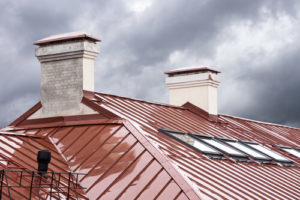When it comes to your chimney safety, it’s important to know that chimney fires are preventable. Chimney ventilation requires optimum airflow, which means all the parts of the system need to be properly installed. When the system isn’t properly maintained or parts of stop working, airflow slows. This causes extra creosote and soot to deposit inside the chimney flue.
When organic materiel is burned in your fireplace, creosote is produced along with smoke and gases. Wood fires produce creosote all winter long, and depending on the type of wood you’re burning, it may produce more or less creosote. The black, shiny material is the worst form of creosote, as it is made up of mostly tar. It is super sticky and highly flammable. The material sticks easily to the flue and can lead to a buildup when it isn’t cleaned away regularly.
Chimney Sweeps Clean Creosote
 When you schedule regular chimney sweeps, they will clean the creosote and soot out of your chimney. According to the Chimney Safety Institute of America (CSIA) and the National Fire Protection Association (NFPA), the chimney systems need to be swept regularly and inspected annually. Annual inspections and sweepings keep your system efficient and safe.
When you schedule regular chimney sweeps, they will clean the creosote and soot out of your chimney. According to the Chimney Safety Institute of America (CSIA) and the National Fire Protection Association (NFPA), the chimney systems need to be swept regularly and inspected annually. Annual inspections and sweepings keep your system efficient and safe.
During a standard chimney sweep, you can expect a Pristine Sweeps expert to arrive and prepare your fireplace opening for service. This includes drop clothes to protect the floor and nearby furniture and a vacuuming system to collect debris from the system. Your breathable air will not be affected by our chimney sweeps, and the creosote will be removed completely.
Glazed Creosote and Your Chimney
When you allow creosote to build up in your chimney system, it can turn to glazed creosote. This is considered a stage 3 buildup, and it is a fire hazard. Glazed state is reached when buildup occurs and then high temperatures heat up the creosote. Water is evaporated from the creosote, leaving behind a hardened, concentrated mass. This glazed creosote is basically concentrated fuel coating the interior of your chimney. The creosote slows the airflow, possibly obstructing it completely and causing the air to stall in the chimney. If the air is super-heated, it can result in a dangerous flue fire.
Glazed Creosote Removal
While creosote and soot are easy to remove with tools such as rods and brushes, glazed creosote is nearly impossible to remove. Only a professional can properly remove glazed creosote without damaging your chimney system. At Pristine Sweeps, we remove glazed creosote using a specially-formulated chemical cleaning product. Our technicians are experienced and trained in applying this product onto glazed creosote. As the creosote absorbs this product, it is transformed and flakes away. After using this product, we are able to brush away and vacuum up the creosote just as if it were soot.
If you suspect your chimney system have creosote buildup or if you haven’t had your chimney professionally cleaned or inspected in the last twelve months, it’s time to call our professionals. Call us at 206-574-8414 or schedule an appointment online.
